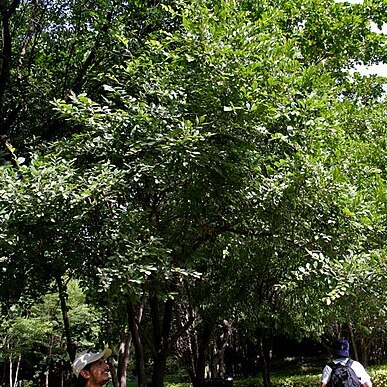Shrubs or trees, usually dioecious; terminal buds absent; wood dense, hard. Leaves deciduous or persistent; petiole often glandular; blade lanceolate to broadly ovate, elliptic, or obovate, coriaceous, surfaces glabrous or pubescent, especially abaxially. Inflorescences 2-15-flowered cymes (staminate) or solitary flowers (pistillate, rarely staminate). Pedicels accrescent in fruit [or not], slender, much shorter to several times longer than flowers. Flowers: sepals persistent, often accrescent in fruit; corolla urceolate to campanulate or salverform, petals usually convolute and imbricate; staminate flowers usually smaller than pistillate flowers; stamens [6-]16(-32), paired and in [1-]2[-5] series; anthers introrse, 2-locular; ovary [3-]8[-16]-locular; ovules 1-2 per locule; styles connate proximally or to near stigmas, slender. Berries yellow, orange, red, purple, brown, or black, fleshy or fibrous. x = 15.
Trees or shrubs, deciduous or evergreen. Terminal buds absent. Branchlet tips sometimes forming a spine. Leaves alternate, occasionally minutely translucent dotted or with gland pits.Flowers dioecious or polygamous. Male flowers in axillary cymes, usually on basal part of current year's branchlets, deciduous soon after anthesis; stamens 4 to numerous, often pairedand forming 2 whorls; ovary rudimentary. Female flowers usually solitary, axillary; staminodes 1--16 or absent; stigma often 2-cleft. Calyx usually 3--5(--7)-lobed, sometimes truncate.Corolla urn-shaped, campanulate, or tubular, 3--5(--7)-lobed, deciduous. Berries fleshy to somewhat leathery, usually with an enlarged persistent calyx. Seeds 1--10(or more), oftenlaterally compressed.
Dioecious or nearly so, the pistillate fls commonly with nonfunctional stamens; fls usually 4-merous; cal deeply lobed; cor urceolate to rotate, with spreading or recurved lobes, those of the staminate and the fertile fls usually different in size; stamens 4–many, usually 16, hypogynous or inserted at the base of the cor; ovary usually 4-locular, or 8-locellar. 400, mainly warm reg.
Seed usually ellipsoid or shaped like a segment of an orange, very rarely subglobose, with 2 lines radiating from the apex; embryo straight or curved in its own plane, radicle not completely surrounded by an invagination of the testa.
Stamens 2–100 or more, included or exserted, solitary or united in pairs or larger groups, adnate to corolla–tube or not; anthers (in our area) dehiscing by longitudinal slits.
Ovary globose, ovoid or conoidal, glabrous or hairy, 3–8 carpellary; carpels (except in section Ferrea) completely or incompletely septate.
Styles usually at least partly free, rarely completely united; stigmata usually fleshy and expanded.
Inflorescence usually cymose or fasciculate or reduced to a solitary flower.
Calyx very variable, 3–8–Iobed or cup–shaped and entire, usually accrescent.
Fruit usually a 1· to many–seeded berry, rarely tardily dehiscent.
Flowers dioecious, the female usually larger than the male.
Pistillode variable, absent to very well–developed.
Disk well–developed or not, sometimes fimbriate.
Staminodes variable, absent to well–developed.
Leaves nearly always alternate, margin entire.
Corolla 3–8–lobed, very variable.
Trees, shrubs or suffrutices.

